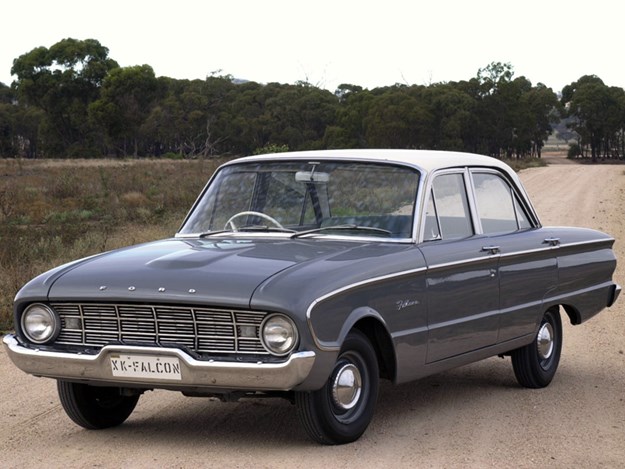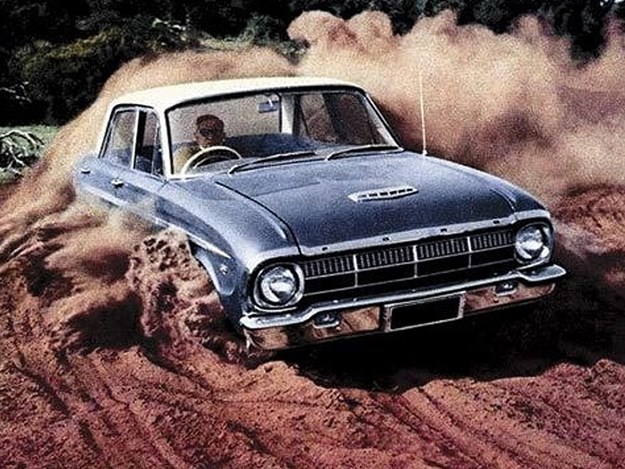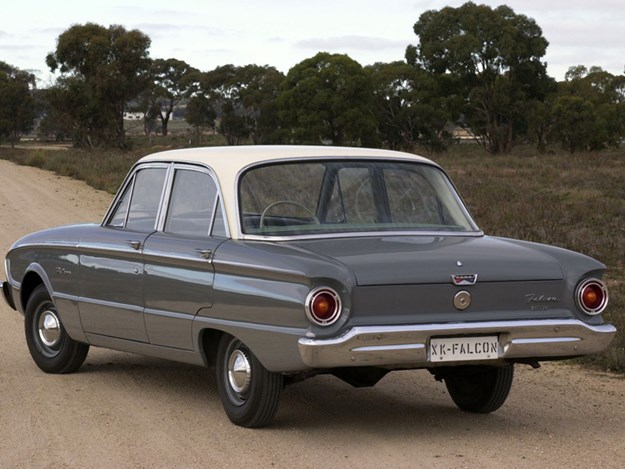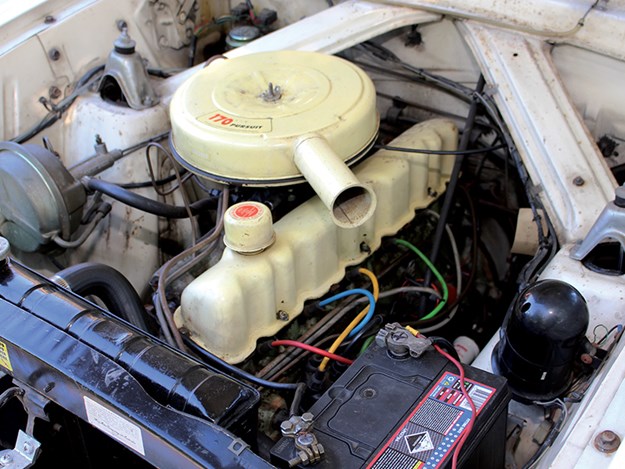Ford Falcon XK-XP 1960-1966 - Buyer's Guide
|
|
Ford Falcon launched here in September 1960, but took time to adapt to its new surrounds
The six-cylinder Falcon was Ford’s contributor to a US ‘compact’ car market while its rivals were weirdly styled, with engineering challenges, or both.
In Australia, the very conventional Falcon was up against an equally conservative but outdated Holden. Victory should have been easy, but Ford failed to understand the challenges its North American design would face when pounded over appalling Australian roads. Horror stories surfaced, sales tanked and various failures cost the company a fortune in warranty costs.
The XK Falcon had been launched in September 1960 as a sleek alternative to Holden’s archaic FB. The shape was low-slung and clean, with elements of full-sized US Fords in its profile and not a fin or slice of excess chrome in sight.

Ford’s base engine was larger than Holden’s 2.3-litre ‘grey’ motor and 12kW more powerful. Holdens came only with three-speed manual transmission but the Falcon, when equipped with the optional 2.8-litre, 77kW ‘Pursuit Six’ engine, could be specified with two-speed automatic transmission.
The Falcon range included a station wagon and, from 1961, a panel van and utility. Wagons and vans came with a nifty wind-down tailgate window, however, the low-roof made vans less practical for some tasks than the taller Holden.
| 2021 Market Review: Ford Falcon/Fairmont XK-XP
Appearing in March 1962, four months ahead of Holden’s restyled EJ, the XL Falcon was marginally improved and accompanied by a marketing campaign centred on the slogan ‘Trim, Taut, Terrific’. The heavy-duty suspension introduced in response to XK front-end failures was standard, as was a modified brake design and water-cooling for the automatic transmission.
A new carburettor and intake system brought minor fuel economy improvements. More significant was the introduction of an up-market Futura sedan and Country Squire station wagon – the latter with ‘woody’ effect side panels made from patterned fibreglass. These had front bucket seats, the Pursuit motor with optional automatic transmission and super-flashy wheel covers.

The shape changed slightly in 1964 to mark the arrival of XM versions. Again, the range expanded to now include two-door Hardtops in Deluxe and Futura trim. A 200 cubic inch (3.3 litre) Super Pursuit engine also became available. Early in 1965, the transformation was complete when an XP version was announced.
| Read next: Ford Falcon history XK-XP 1960-1966
Cars with the Super Pursuit motor and its 90kW of power meant a Falcon that would reach 150km/h and easily tow a caravan or boat. It was also way more durable than early models.
Just knowing the XP was better was not enough, however, as Ford insisted on proving the toughness of its XP range with a 70,000 Mile Durability Run. This was a multi-car event with five Falcons being driven day and night around the inhospitable You Yangs Proving Ground. All five cars finished – some looking ready for the crusher after repeated crashes – but Ford’s reputation was restored.
| Classic: Ford Falcon XL/XM
Almost 145,000 XK-XL Falcons were built, 47,000 XMs and 71,000 XPs. As our survey numbers reveal, surviving XPs outnumber all other types of early Falcon combined. Values for good sedans remain generally stable and below $25,000, however, Futura Hardtops are scarce and seem headed for $70,000.
Value range: Ford Falcon (XP manual)
Fair: $7000
Good: $18,000
Excellent: $28,000
(Note: exceptional cars will demand more)

BUYER'S CHECKLIST
Body & chassis
Surviving XK-XPs won’t display the rot that was typical 20 years ago but check mudguards, sills and door skins for bubbles or filler, floors and inner sills for structural rust. Rust-free tailgates for wagons and commercial models are scarce, and make sure the window winds freely. Good-quality chrome is difficult to find. Some rust repair panels are commercially available but finding a sound car will be way more economical than trying to renovate a rusty one. Full sets of body rubbers cost around $1500 and good, second-hand panels have sold via on-line auction sites for around $500 per item.
Engine & transmission
Virtually everything you need to rebuild an old Falcon motor is available and none of it seems outrageously expensive. If an early engine is tired and authenticity isn’t a concern, replacing the 2.3-litre engine with a 2.8 or the ‘Super Pursuit’ 3.3-litre is worth considering. Look for exhaust smoke denoting piston ring or cylinder wall wear, listen at start-up for chattering tappets or timing chain rattles. The two-speed transmission can be jerky on the 1-2 up change but if the shift takes longer than a second or is accompanied by vibration there are transmission problems. Upgrading to the later three‑speed auto is cheaper than fixing a two‑speed.
Suspension & brakes
These were the areas which generated most of the problems experienced by early Falcons. XKs were modified after a factory recall with stronger wishbone mounts and heavier ball joints but early cars can still suffer problems due to wear and abuse. Ball joints, springs and shock absorbers are all available and reasonably priced but replacement stub axles are difficult to find. Jacking up each front wheel to check for wheel-bearing movement is recommended. Standard drum brakes need to be in near-perfect condition to deliver adequate performance but can be replaced with discs from later models.

Interior & electrical
Original trim is virtually impossible to find, so choosing a car with well-preserved seats is a bonus. On the plus side, interior and door rubbers, dash knobs and instruments can be sourced second-hand or new from suppliers of reproduction parts. Original vacuum-operated wipers move at their slowest when the car is at full throttle, so conversion to electric operation is welcome Starter motors are a Ford weak point – noisy even when working properly and prone to jamming if worn. If a car has the optional heater/demister, ensure it is working as reconditioned units have been advertised at close to $1000.
1960-1966 Ford Falcon XK-XP specs
NUMBER BUILT: 68,413 (XK) 75,705 (XL) 47,039 (XM) 70,998 (XP)
BODY STYLE: All steel, integrated body/chassis four-door sedan, wagon, coupe, van and utility
ENGINE: In-line 2365cc, 2781cc or 3273cc inline six-cylinder with overhead valves & single carburettor
POWER & TORQUE: 75kW @ 4400rpm, 212Nm @ 2400rpm (2.8 Pursuit)
PERFORMANCE: 0-96km/h 14.8 seconds 0-400 metres 20.2 seconds (2.8 manual)
TRANSMISSION: Three-speed manual or two or three-speed automatic
SUSPENSION: Independent with wishbones, coil springs, shock absorbers and anti-roll bar (f), Live axle with semi-elliptic springs and shock absorbers (r)
BRAKES: Drum (f), drum (r)
TYRES: 6.00 x 13 or 6.50 x 13 cross-ply
From Unique Cars #469, Aug/Sep 2022
Unique Cars magazine Value Guides
Sell your car for free right here
Get your monthly fix of news, reviews and stories on the greatest cars and minds in the automotive world.
Subscribe


.jpg)



![2008 FORD GT FG Sedan 4dr Spts Auto 6sp 5.4i [May]](http://assets.primecreative.com.au/imagegen/cr/100/75/assets/momoads/2024/08/03/230915/277_1.jpg)
![2005 FORD FALCON BF XR8 Sedan 4dr Spts Auto 6sp, 5.4i [Oct]](http://assets.primecreative.com.au/imagegen/cr/100/75/assets/momoads/2024/08/20/231723/307_1.jpg)








